Factors to consider when specifying automatic revolving doors
To download this article, please click here ➤
Automatic Revolving Doors are a great way to create a grand, visually stunning and welcoming entrance to a building, they also prevent unwanted air infiltration, reduce energy costs and contribute to a superior indoor climate, making them the number one choice for architects, specifiers and end users.
As with all automatic door systems, the key to their post occupancy success and overall client satisfaction is their correct specification from early design phase.
This is where the manufacturers Specification Managers enter the equation offering technical advice and support in the design and integration of the revolving door/s to all involved. After all, if the revolving door becomes a barrier to access due to incorrect specification it may lead to dissatisfaction post occupancy due to queues forming at peak times.
To avoid this and ensure success, there are many factors that should be considered.
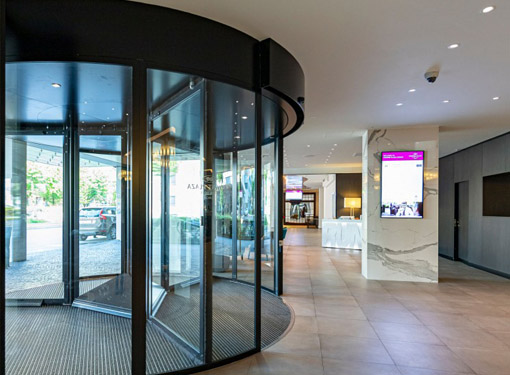
Why do peak flow rates affect whether a 3-wing or 4-wing automatic revolving door should be chosen?
The theoretical pedestrian flow rate of a revolving door is dictated by the proposed internal diameter, quantity of wings, and peripheral speed (limited by EN16005). Therefore, an understanding of the predicted demand at peak times is essential to determine the minimum diameter and quantity of revolving doors required.
As an example, a typical 4 wing automatic revolving door with a diameter of 2400mm, rotating at 0.77m/s or 6.12 rotations per minute, would have a throughput capacity of approximately 31 people per minute or 1,900 people per hour based on one person occupying each segment.
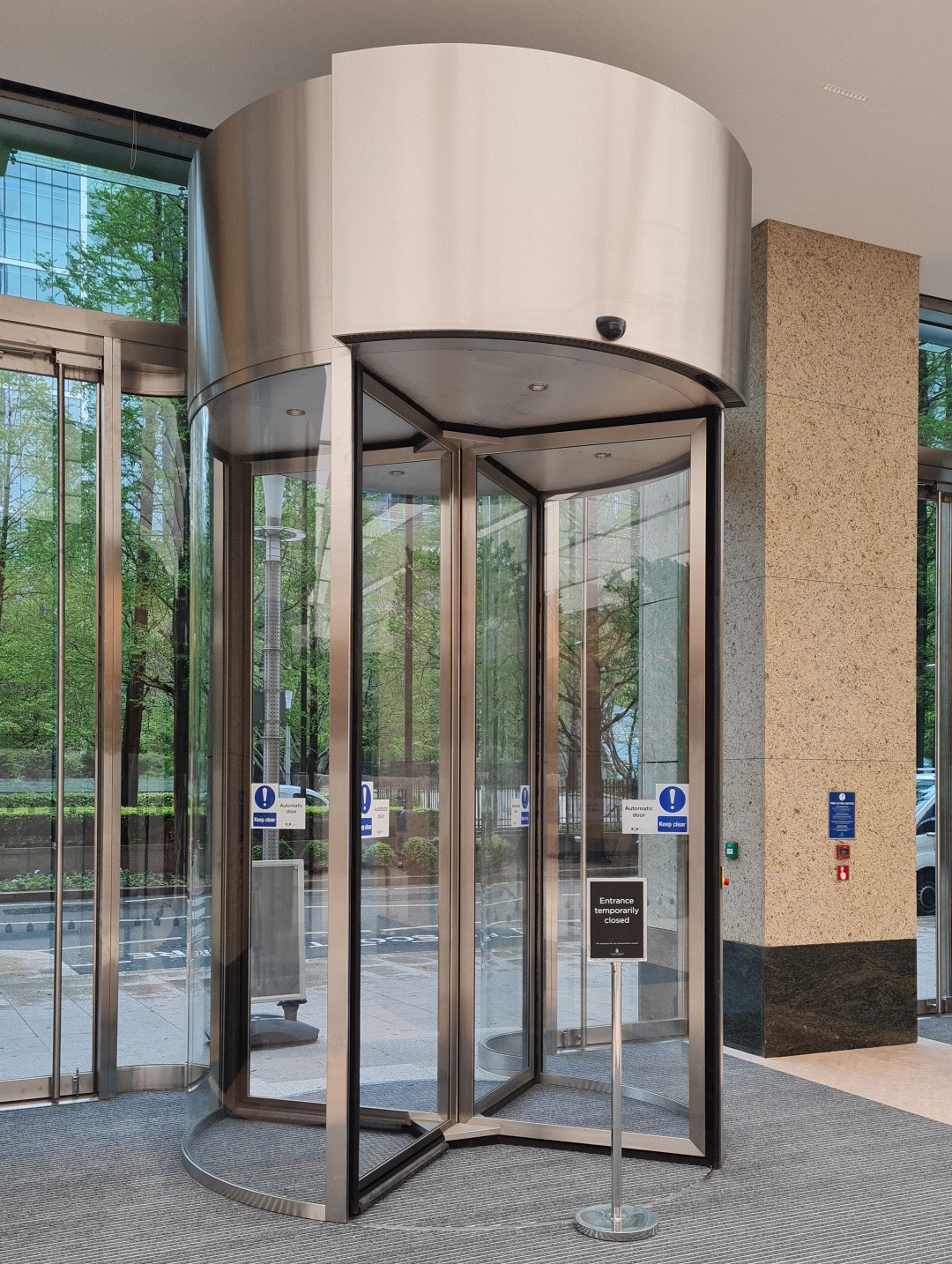
Of course, it is expected that a large influx of office workers will enter a building between the hours of 08.30 -09.30 each morning.
At this point a single revolver might quickly become overwhelmed when large volumes of pedestrians arrive at the same time. This might force the use of the pass door as an alternative point of entry somewhat defeating the indoor climate benefits intended when selecting a revolving door.
This is particularly relevant during inclement weather conditions and additional doors should be considered to remove the risk of queues forming, especially considering the current need for social distancing.
As an alternative, a high throughput 360Ocurved sliding door system might be a consideration or even as an addition when pedestrian footfall demand might overwhelm a revolver’s capacity. A curved sliding door offers relatively unimpeded traffic flow, it can be used on an emergency escape route and can create a very similar aesthetic to a revolving door.
It is more challenging to control the indoor climate with this type of system but the addition of a warm air curtain, reduced opening width in the winter and interlocking the inner and outer doors (where possible) can help to negate this. The added benefit of a curved slider is that you do not need a separate pass door, unlike a revolving door.
Automatic Revolving doors must comply with British Standard EN16005 to ensure safety.
Revolving doors are safer than ever but to ensure their safety in use they must comply to EN16005 which states the minimum required measures to protect pedestrians using an automatic door system. A specification manager should be EN16005 certified and carry out a risk assessment on every automatic door they specify to ensure the door system will be safe in operation (as per EN16005) and suitable for the application.
On a revolving door there are multiple danger points see photo on th right, which are protected by a combination of ESPE or PSPE sensors (electrosensitive protective equipment/pressure sensitive protective equipment) which, when activated, are designed to stop the rotation of the door to prevent injury. As the names suggest these sensors are sensitive and need to be easily activated.
As anyone who has used an automatic revolving door knows there is a sensor on the bottom of the revolving wing which, if it catches your heel, stops the automatic door. After a short delay, once you have removed your foot from the sensor the door moves again.
The sensors are there for a very good reason however, if segments are too small and people are shuffling through them these sensors can be easily activated resulting in frustrating delays and unimpressed end users.
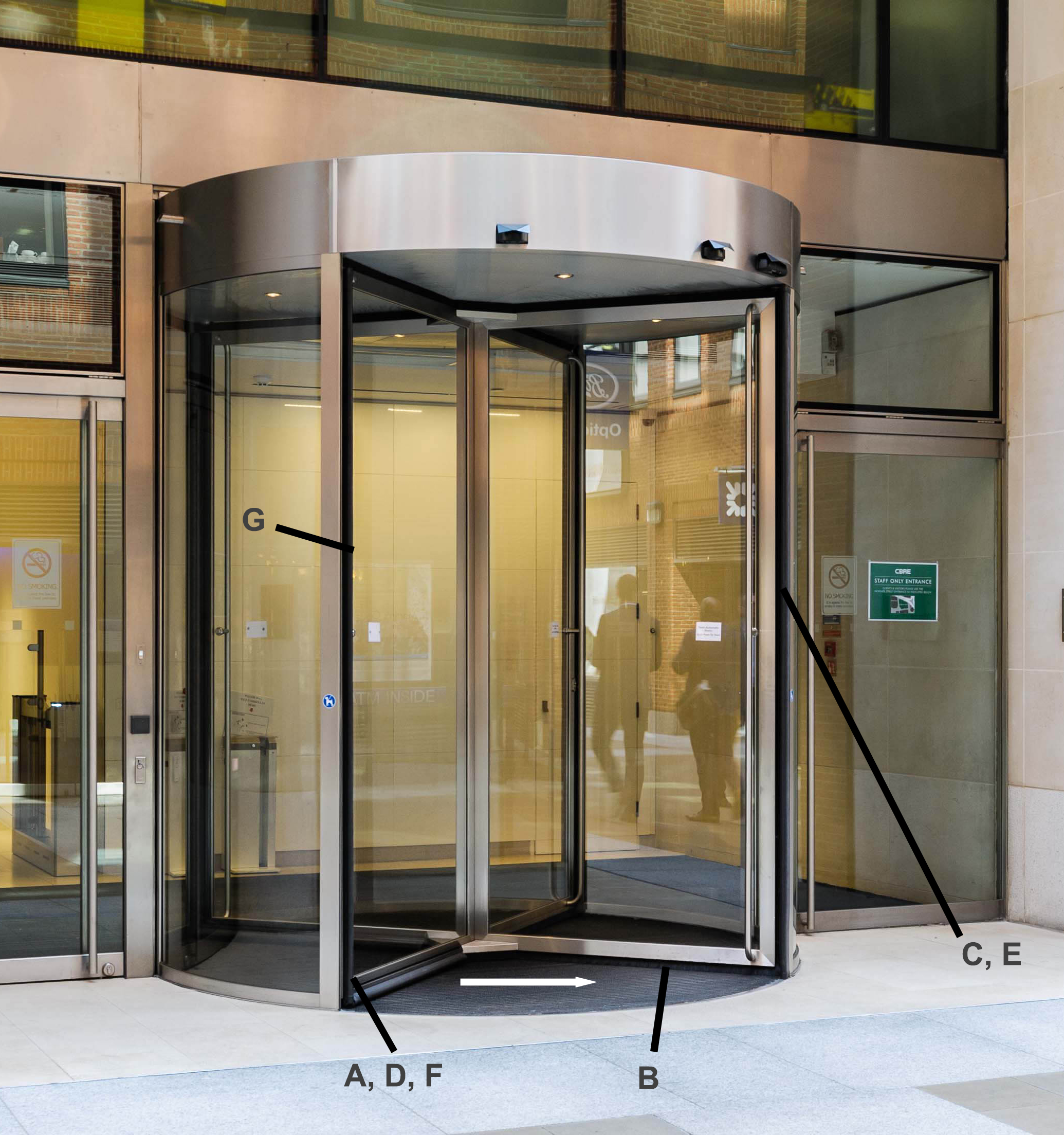
A Main Closing Edge
B Secondary Closing Edge
C Opposing Closing Edge
D Leading Edge
E Leading Mullion
F Outer Stile
G Trailing Mullion
How to choose between a 3-wing and 4-wing automatic revolving door
The classic 4-wing revolver is the most popular choice and is particularly suitable for higher volume, two-way pedestrian traffic flow requirements in commercial office applications. It also offers improved indoor climate control due to the construction of the leading mullions and wings that form an improved seal (fig 2) when compared to a 3-wing type.
A 3-wing offers a slightly lower throughput capacity and narrower clear opening but offers more comfort as there is more space in each segment and is therefore better suited to low traffic environments.
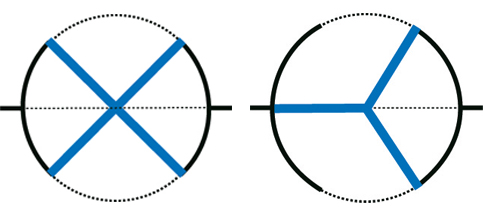
User comfort and Façade Connection when using an automatic revolving door
As mentioned previously the contribution a revolving door can offer to indoor climate control is a major benefit and user comfort can be further improved by integrating a warm air curtain either electrically powered heat or warm water fed within the canopy of the revolving door.
A revolving door manufacturer will also assist with the integration of the revolving door system into the façade of the building using either glass to glass, glass to metal or metal to metal façade connections depending on the positioning of the door system and façade construction.
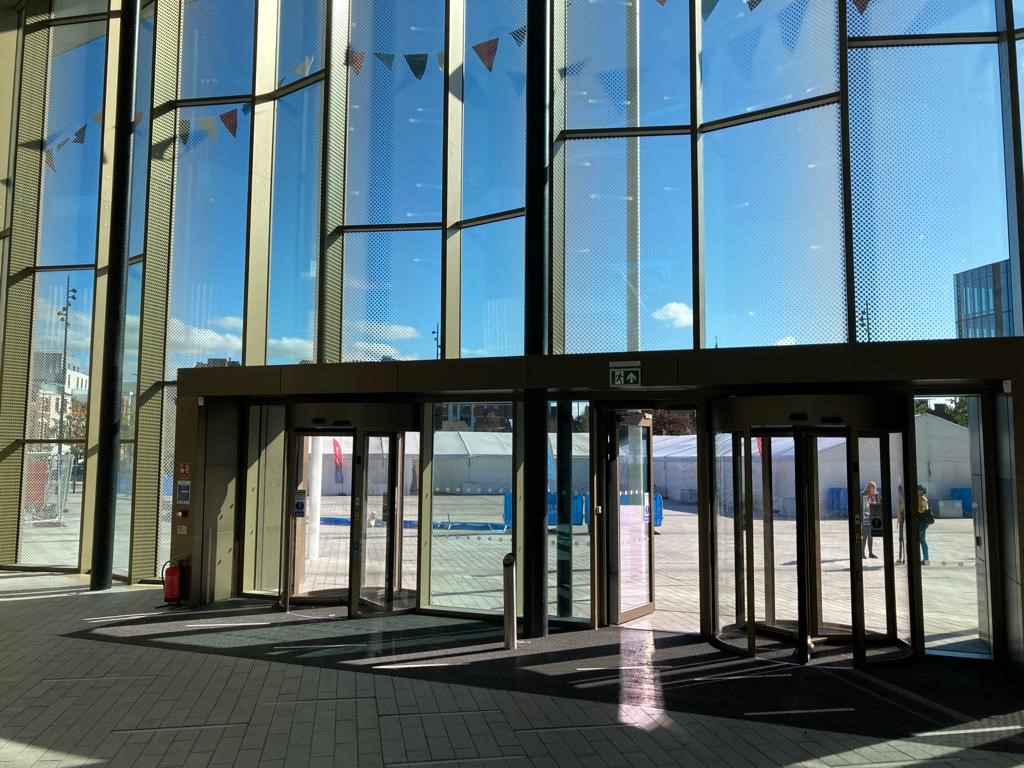
Security aspects to consider with automatic revolving doors
There are typically two types of security required which are described below.
Physical security, against break-in attempts which would require testing to relevant security standards such as EN1627 incorporating RC1 – RC6 and PAS 24 (PAS 24 or equal as per Part Q building regulations for residential application) and LPS 1175 incorporating ratings from SR1 – SR 8.
Operational security relates to anti- piggyback and anti-tailgating technology to prevent unauthorised access.
Automatic Operation – In-floor or Over-head Drives
An overhead drive gives the designer the option to incorporate a warm air curtain and lighting into the solid roof canopy of a revolving door maximising user comfort.
In-floor operator options (where floor space allows) are available for automatic curved sliding, revolving and linear sliding door systems and when combined with an all-glass type construction help the designer deliver a minimal aesthetic, maximise light transmission and help to create the ultimate wow factor.
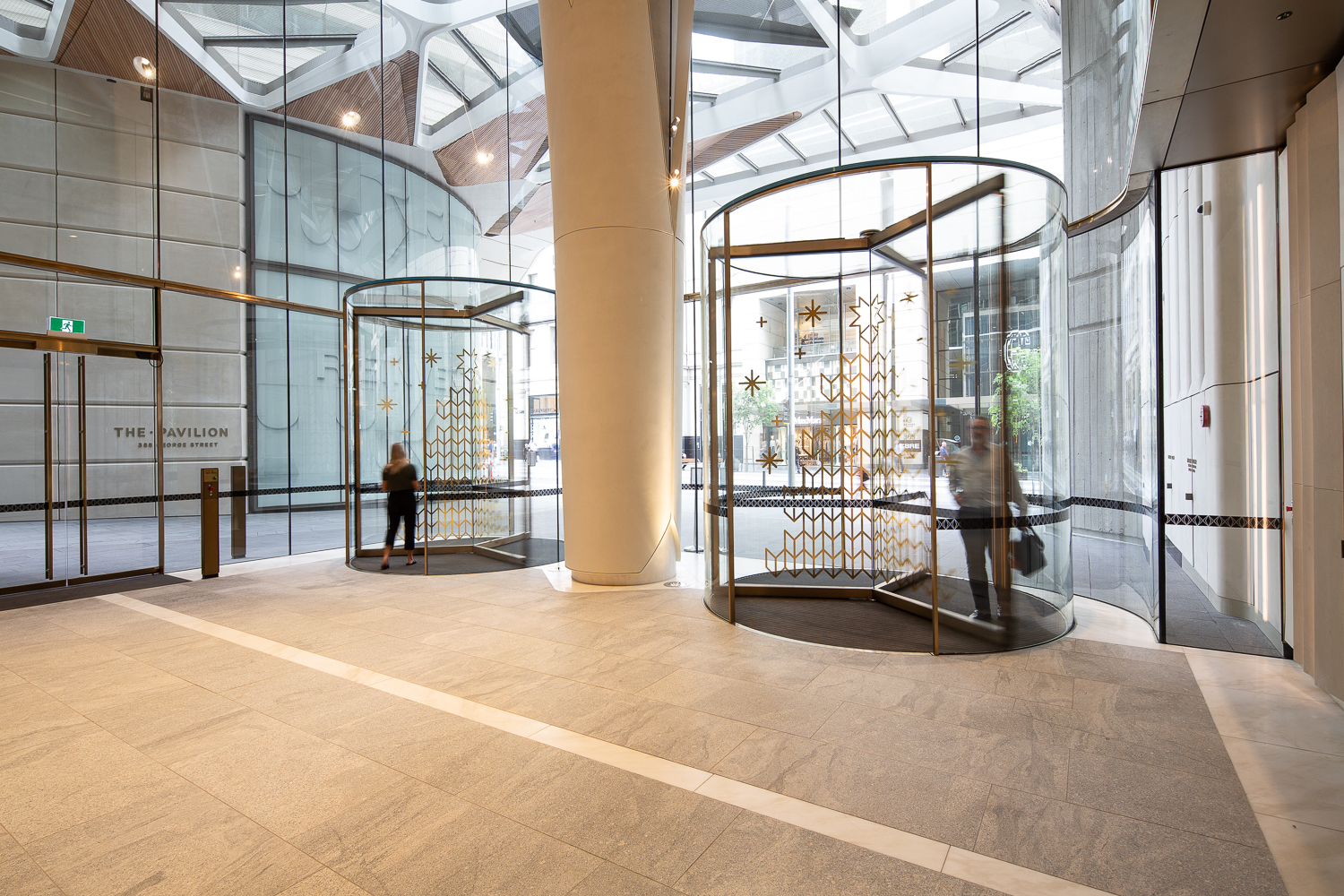
In short, it is vital to ensure the requirements of both the building envelope and building owner are met at the Specification stage. If unsure of which revolving door is the most suitable, get advice from the door manufacturer’s Specification Manager. This way you can avoid any misunderstandings which can lead to safety issues, delays in installation and valuable time and money being wasted.
To download this article, please click here ➤
| We offer specification and architect support services with this product... |
record provide specification and architect support services for automatic revolving doors as well as other automatic door systems. Click here to visit our dedication specification support page and to discuss your requirements and queries with our UK Automatic Door Specification Manager.




